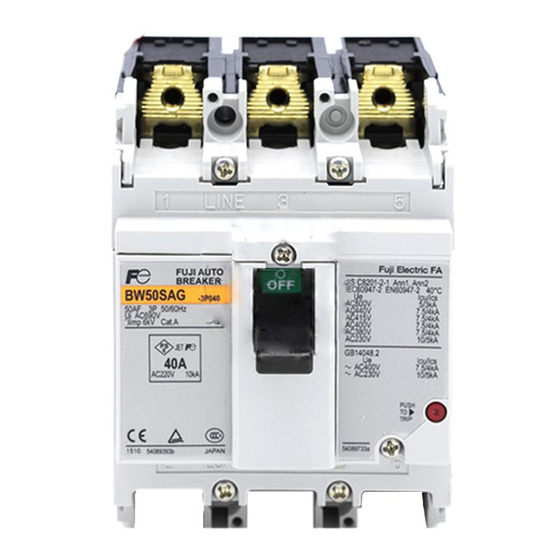Summarization of Contents
Chapter 1 Protecting low-voltage circuits
1-1 Description
Overview of low-voltage circuit faults and protection measures.
1-2 Overcurrent protection
Explains overcurrent faults, overload, and short-circuit protection concepts.
1-3 Phase-loss protection
Details phase-loss faults and protection methods for motors.
Chapter 2 Operating characteristics and performance
2-1 Overcurrent tripping characteristics
Discusses types of overcurrent tripping and factors affecting them.
2-2 Breaking performance
Details short-circuit current breaking capabilities and related parameters.
2-3 Overload switching performance
Covers performance during overload switching tests.
2-4 Performance with current at 100%
Examines temperature rise and power consumption at rated current.
2-5 Durability
Addresses switching durability and trip switching durability.
2-6 Withstand voltage performance
Outlines requirements for power frequency and impulse withstand voltages.
2-7 Handle operating force and angle
Specifies operating force and angle parameters for handles.
Chapter 3 Selection and application
3-1 Selection check points
Key factors to consider when selecting MCCBs for various applications.
3-2 Cascade trip applications
Details on coordinating breakers for backup protection to ensure reliability.
3-3 Selective trip applications
Explains how to achieve selective tripping between devices for improved selectivity.
3-4 Wiring protection
Focuses on protecting wiring from thermal effects of overcurrents.
3-5 Motor circuit applications
Covers protection strategies for motors, including starting currents.
3-6 Applications on the primary side of transformers
Addresses selecting MCCBs for transformer primary circuits, considering inrush current.
3-7 Welder circuit applications
Discusses MCCB selection for arc and resistance welder circuits.
3-8 Selecting an MCCB for capacitor circuit
Details considerations for protecting capacitor circuits from inrush and residual voltage.
3-9 MCCBs for semiconductor circuit
Covers protection of circuits with semiconductor devices like thyristors.
3-10 Protecting SSCs using MCCBs or MMSs
Explains protection of Solid State Contactors (SSCs) for heater and motor circuits.
3-11 Protecting inverter circuits using MCCBs
Discusses MCCB selection for protecting inverter circuits.
3-12 MCCBs for high frequency circuits
Addresses MCCB suitability and derating for high-frequency applications.
3-13 MCCBs for DC circuit applications
Details MCCB usage and special considerations for DC circuits.
3-14 MCCBs for UPS applications
Covers selecting MCCBs for Uninterruptible Power Supply (UPS) systems.
3-15 MCCBs for servo amplifier applications
Discusses MCCB selection for servo amplifier power supply.
3-16 Ground fault protection in system applications
Explains grounding methods and ground fault protection strategies.
Chapter 4 Environment and usage precautions
4-1 Standard conditions
Specifies standard operating conditions for MCCB performance and usage.
4-2 Application to special environments
Details considerations for using MCCBs in high-temperature, cold-climate, and high-altitude environments.
4-3 Connection precautions
Covers important aspects of proper conductor connection and tightening torque.
4-4 Malfunction due to transient inrush current
Discusses preventing malfunctions caused by transient inrush currents.
Chapter 5 Maintenance inspections
5-1 Faults and causes
Identifies common faults, their causes, and recommended countermeasures.
5-2 Periodic inspections
Outlines procedures for initial and periodic inspections to ensure proper function.
5-3 Replacement recommendations
Provides guidelines for diagnosing deterioration and recommending replacement.
Chapter 6 Short-circuit current calculation
6-1 Calculating short-circuit current
Explains the objective, formulas, and steps for calculating short-circuit current.








Need help?
Do you have a question about the EW32AAG and is the answer not in the manual?
Questions and answers